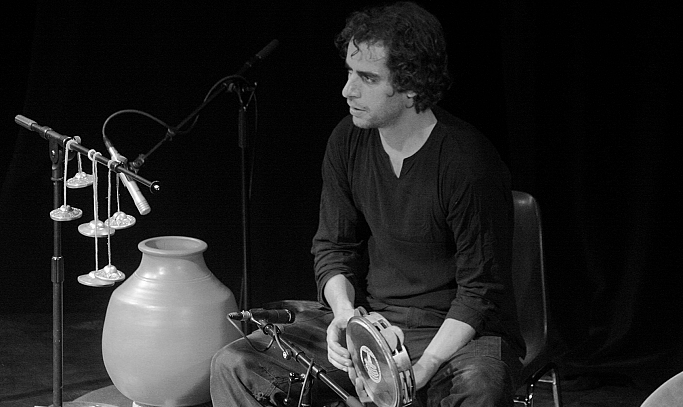The Scottish Ensemble are a group of very skilled chamber musicians, and they love to experiment with musical cultures that differ from their normal repertoire. Sometimes it works sometimes it doesn’t, but this afternoon at Summerhall a large audience are entranced by their musical excursion to the East. The five musicians of the Scottish Ensemble, led by musical director Jonathan Morton on violin—with Daniel Pioro, violin; Jane Atkins, viola; Alison Lawrance, Cello; and James Manson, double bass—are joined by musicians from the East: two Iranian brothers, Bijan and Keyvan Chemirani, who play a variety of different percussion instruments, and Greek musician Sokratis Sinopoulos, who plays the traditional Greek lyra (which makes a very big noise from a very small instrument).
Morton in his introductory note says, “rhythm, melody and harmony are the three intertwined trunks of the musical tree and Continental Drift is about exploring these three elements across continents and centuries”. This they do in a very unique manner, playing some baroque classical works on their own, some traditional music from Persia, India and Greece, and most interestingly of all, a combination of the two traditions in music by Bartók, Purcell and Rameau. Now, of course, it is true that classical composers have often used folk music in their works, but here we have very good examples of the similarities between western baroque music and the classical music of India, Turkey and Iran.
Keyvan Chemirani, in a very interesting article by Keith Bruce of The Herald in the programme says, “all this music was created for princes and kings and to a small audience. The music is spiritual and designed for a small room, literally chamber music. The sound of the instruments is not very powerful but warm and delicate”. This stands out in today’s programme, the often delicate touches from the zarb, the Persian drum, picked up by the Lyra, the instrument at the centre of Greek traditional music, which are then backed up by the western instruments of violin, viola and cello. The eastern music is often used to accompany dance. Indeed, one tune is for whirling dervishes, but of course, western baroque music was often used for dance too.
Hence, it is very fitting the concert ends with both sets of musicians playing Rameau’s dance music for Les Indes galantes. The large audience at Summerhall are delighted, and we go home convinced that we have been to a unique and memorable concert.
